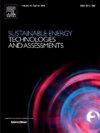Experimental examination of a boiler heat exchanger using nanofluids: Thermo-energetic and enviro-economic analysis
IF 7.1
2区 工程技术
Q1 ENERGY & FUELS
Sustainable Energy Technologies and Assessments
Pub Date : 2025-07-21
DOI:10.1016/j.seta.2025.104460
引用次数: 0
Abstract
Single and hybrid nanofluids have been widely employed in different thermal systems, showing notable thermal advancements. The current work examines zinc oxide (ZnO) and hybrid multi-wall carbon nanotubes-zinc oxide (MWCNT-ZnO)-based nanofluids to maximize the thermal energy of boilers and assist sustainability. Energetic parameters, such as boiler efficiency and electric power consumption, are also quantified for proposed nanofluids compared to conventional water. Moreover, an enviro-economic analysis was presented to show the CO2 emission minimization and electric energy cost savings on a daily basis. Experimental outcomes revealed that the MWCNT-ZnO hybrid nanofluid has increased the heat transfer rate, convective heat transfer coefficient, and Nu to about 4252 W, 1524 W/m2·K, and 226.19, when at 0.02 % and inlet temperature of 55.94 °C. However, minimum friction factor and pressure drop were reported for water compared to using ZnO and MWCNT-ZnO nanofluids. The hybrid nanofluid augmented boiler efficiency and electric power consumption by about 7 % and 43 %, respectively over water usage, indicating remarkable thermo-energetic progress. Moreover, the enviro-economic analysis results showed that using mono and hybrid nanofluids has decremented CO2 emissions and saved energy costs by about 22 % and 30 % by employing ZnO and MWCNT-ZnO nanofluids, respectively.
使用纳米流体的锅炉热交换器的实验研究:热能和环境经济分析
单纳米流体和混合纳米流体在不同的热系统中得到了广泛的应用,显示出显著的热性能进步。目前的工作研究了氧化锌(ZnO)和混合多壁碳纳米管-氧化锌(MWCNT-ZnO)为基础的纳米流体,以最大限度地提高锅炉的热能和协助可持续发展。与常规水相比,所提出的纳米流体的能量参数,如锅炉效率和电力消耗,也被量化。此外,环境经济分析显示了二氧化碳排放量的减少和电力能源成本的节约。实验结果表明,当进口温度为55.94℃,进口温度为0.02%时,MWCNT-ZnO复合纳米流体的换热率、对流换热系数和Nu分别达到4252 W、1524 W/m2·K和226.19 W。然而,与使用ZnO和MWCNT-ZnO纳米流体相比,水的摩擦系数和压降最小。混合纳米流体使锅炉效率和电力消耗分别比用水提高了约7%和43%,表明了显著的热能进步。此外,环境经济分析结果表明,使用ZnO和MWCNT-ZnO纳米流体分别减少了约22%和30%的二氧化碳排放和能源成本。
本文章由计算机程序翻译,如有差异,请以英文原文为准。
求助全文
约1分钟内获得全文
求助全文
来源期刊

Sustainable Energy Technologies and Assessments
Energy-Renewable Energy, Sustainability and the Environment
CiteScore
12.70
自引率
12.50%
发文量
1091
期刊介绍:
Encouraging a transition to a sustainable energy future is imperative for our world. Technologies that enable this shift in various sectors like transportation, heating, and power systems are of utmost importance. Sustainable Energy Technologies and Assessments welcomes papers focusing on a range of aspects and levels of technological advancements in energy generation and utilization. The aim is to reduce the negative environmental impact associated with energy production and consumption, spanning from laboratory experiments to real-world applications in the commercial sector.
 求助内容:
求助内容: 应助结果提醒方式:
应助结果提醒方式:


